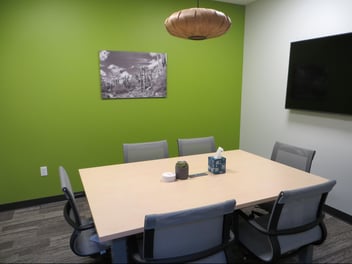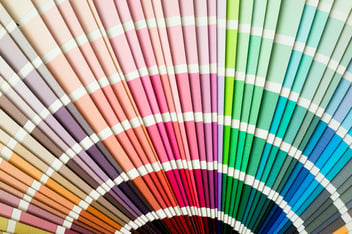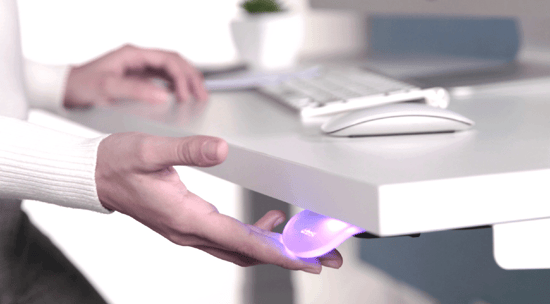Office Colors for Creativity & Energy in 2025
Today we'll discuss a topic that may be of interest to many when it comes to decorating an office: What are the ideal colors to paint an office?
Vibrant and bright colors in the office can foster creativity and increase energy. Often, the office can be a monotonous and dull environment, but the use of colors can radically change the atmosphere and enhance the productivity and well-being of the workers.
As companies strive to create more appealing and productive work environments, interior designers are utilizing color psychology to create spaces that inspire and motivate employees. Instead of white walls and neutral furniture, offices are embracing vibrant and bold colors in their interiors as a new trend.
Here are some ideas on how you can use colors in office for creativity and focus:
Vibrant colors can help stimulate creativity and energy in the office.
For example, orange is considered the color of creativity as it encourages innovation and enthusiasm, while red can be a stimulus for productivity and motivation. On the other hand, green and blue are colors associated with relaxation and calmness, which can be useful in workspaces that require concentration.
Caution: Not everyone reacts the same way to colors.
It's important to consider that some individuals may find bright colors too stimulating and prefer softer shades. Therefore, it's important to take into account the culture and preferences of employees when choosing appropriate tones, intensity, and amount of color for the office. Tips to achieve this:
1. Consider how colors blend.
Using a consistent and balanced color palette can create a pleasant and appealing atmosphere in the office without overusing flashy colors.
2. Use colorful accessories.
Another way to incorporate colors into office interiors is through accessories. Cushions, curtains, rugs, and artwork can be an excellent way to add color to the office. You can also opt for brightly colored desks or chairs to add a fun and creative touch to your workspace.
3. Place plants and flowers in the office.
In addition to adding color to the office, plants and flowers can also help improve air quality and uplift the mood of workers. Green plants can help reduce stress and visual fatigue, while brightly colored flowers can brighten the environment and enhance the mood.
4. Use colors in event decoration.
If you're planning an event in the office, you can use the recommended colors to create an appealing and energizing ambiance. Use brightly colored tablecloths and tableware, and decorate the office with balloons and colorful flowers. This can help boost morale and motivation during these special occasions and give a boost to the rest of the week.
Impact of Lighting on Color Perception in Offices
The interplay between lighting and color is crucial in office design, significantly influencing the mood, productivity, and overall well-being of employees. The type of lighting, whether natural or artificial, and its temperature (warm or cool) can drastically alter how colors are perceived within a space. Natural light, with its full spectrum, tends to render colors most accurately and vibrantly, creating a more dynamic and stimulating environment.
Maximizing natural light through large windows, skylights, and open layouts is often a primary goal in modern office design, as it has been linked to improved mood, reduced eye strain, and enhanced cognitive performance.
Artificial lighting, on the other hand, offers greater control and can be strategically used to complement or enhance the natural light. Warm lighting (lower Kelvin temperatures, typically below 3000K) tends to make colors appear richer and more inviting, fostering a sense of comfort and relaxation. This can be ideal for break areas or collaborative zones where a more casual atmosphere is desired. Conversely, cool lighting (higher Kelvin temperatures, typically above 4000K) mimics daylight and can make colors appear crisper and more vibrant, promoting alertness and concentration.
This is often preferred for task-oriented areas or spaces requiring high visual accuracy. When designing an office, it's essential to consider how different light sources will interact with the chosen color palette to create a harmonious and functional environment that supports the intended activities and emotional responses. Strategic placement of luminaires, use of dimmers, and selection of appropriate bulb types can fine-tune the visual experience, ensuring that colors are always seen in their best light.
Color Trends in Office Design for 2025: Beyond White
Office design in 2025 is moving beyond the traditional sterile white and gray palettes, embracing a more diverse and expressive range of colors to create dynamic and inspiring workspaces. The emerging trends reflect a growing understanding of color psychology and its impact on employee well-being, creativity, and productivity. While neutrals still form a foundational base, designers are increasingly incorporating bolder accent colors and integrating natural elements to infuse vitality into the office environment. Earthy tones, such as terracotta, deep greens, and warm browns, are gaining popularity, reflecting a desire for biophilic design and a connection to nature. These colors evoke a sense of calm and stability, promoting focus and reducing stress.
Beyond natural hues, vibrant and energetic colors are being used strategically to stimulate creativity and collaboration. Think of rich blues that inspire trust and communication, or optimistic yellows that foster innovation. These colors are often applied in collaborative zones, brainstorming areas, or as accent walls to create visual interest and define different functional zones within an open-plan office. Furthermore, the trend towards personalized and flexible workspaces means that color can be used to create distinct micro-environments within a larger office. For example, a quiet zone might feature cooler, more subdued tones, while a high-energy collaboration hub could incorporate brighter, more stimulating colors. The goal is to create a visually engaging and emotionally intelligent workspace that supports diverse work styles and enhances the overall employee experience, making the office a place where people genuinely want to be.
Whether it's painting the walls, using colorful accessories and plants, or fostering creativity through event decoration, colors can be a valuable tool to create a more pleasant and motivating work environment.
We hope this information is useful for your company, and that you can apply these ideas in your own office.



.webp?width=352&name=rueda-de-color-color-wheel%20(2).webp)

